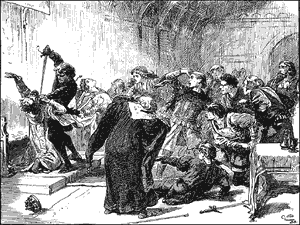
Introduction
 |
Here's a pattern of events that's not unfamiliar to Shakespeare's audiences: A person we recognize to be good ends up carrying out some horrible deed as a result of being intentionally deceived by an evil advisor who is trusted by him. In the end, the perpetrator of the terrible act confirms our sense of his basic goodness with his spontaneous display of revulsion at his own act, when he comes to recognize his error. The evil advisor, on the other hand, seems all the more evil for encouraging others to vice. Worse than being a sinner oneself, is encouraging sin in others.
While this process is evident in plays like Othello or Much Ado About Nothing, it is not so easy to discern in Hamlet. Nonetheless, imagine an Elizabethan audience suspecting that the ghost is demonic. As we see from the guidelines laid out by James I, it is the very fact that an apparition encourages sinful acts, that it can be understood to be of demonic origin."We must note," says James I, "whether the spirit teache ought that doth varie from the doctrine of the apostles, and other doctoures approued by the Churches censure:" To an Elizabethan audience it was clear that the ghost's urgings counter the approved doctrines of the Christian church. To follow, or yield to them, then, is to allow them to guide one's descent into evil.
Whether or not this seemed to be Hamlet's trajectory depends on the extent to which Elizabethan society held revenge to be both immoral and illegal. Hamlet, himself, is troubled by the course of action recommended by the ghost. Yet, in the end, he follows it. For some, his progress in the play is one of resisting evil, then stumbling into it, and eventually wallowing in it. In itself, this viewpoint makes for an interesting interpretation of Shakespeare's play.